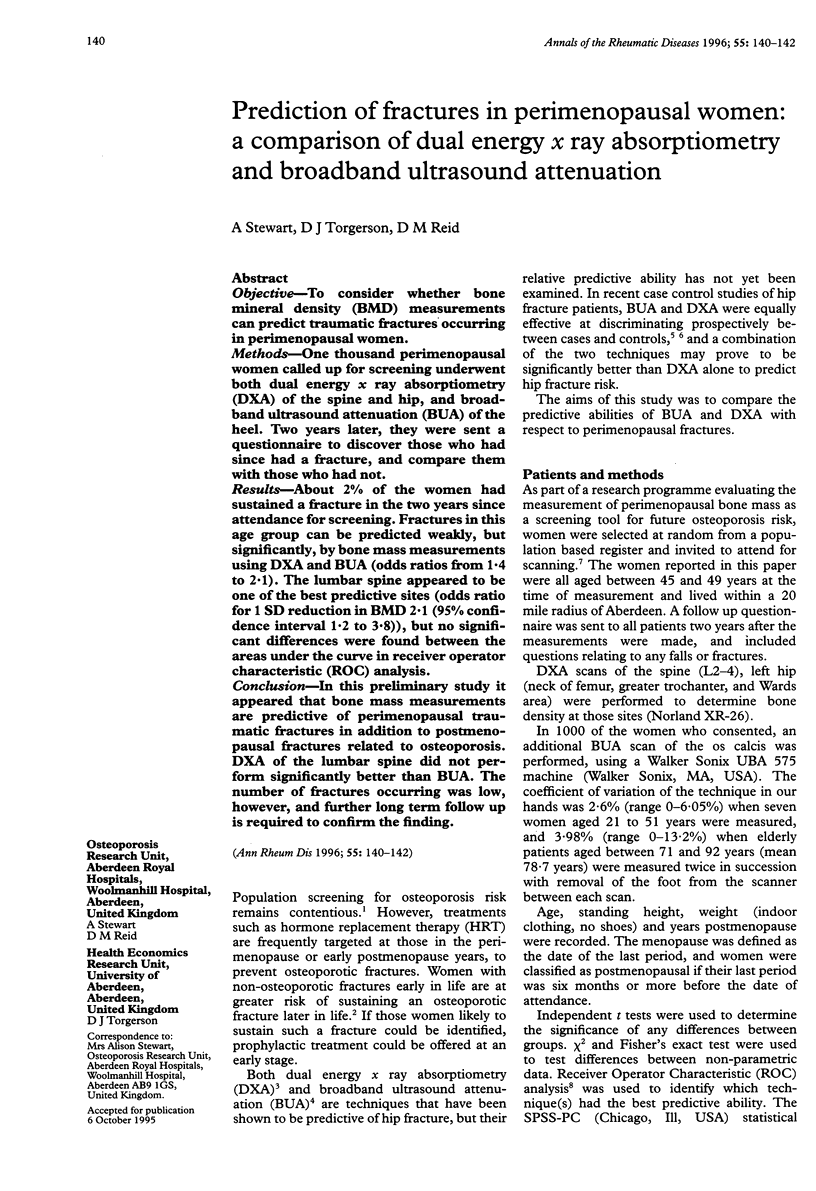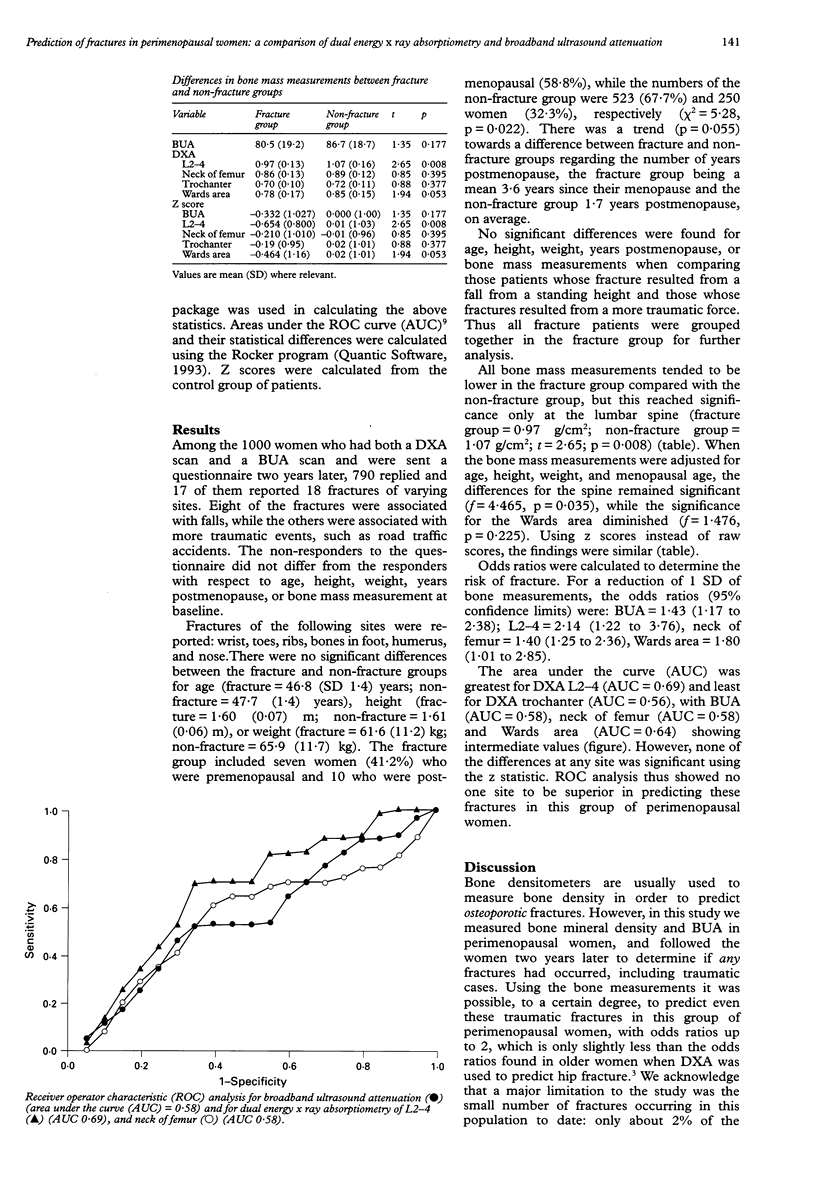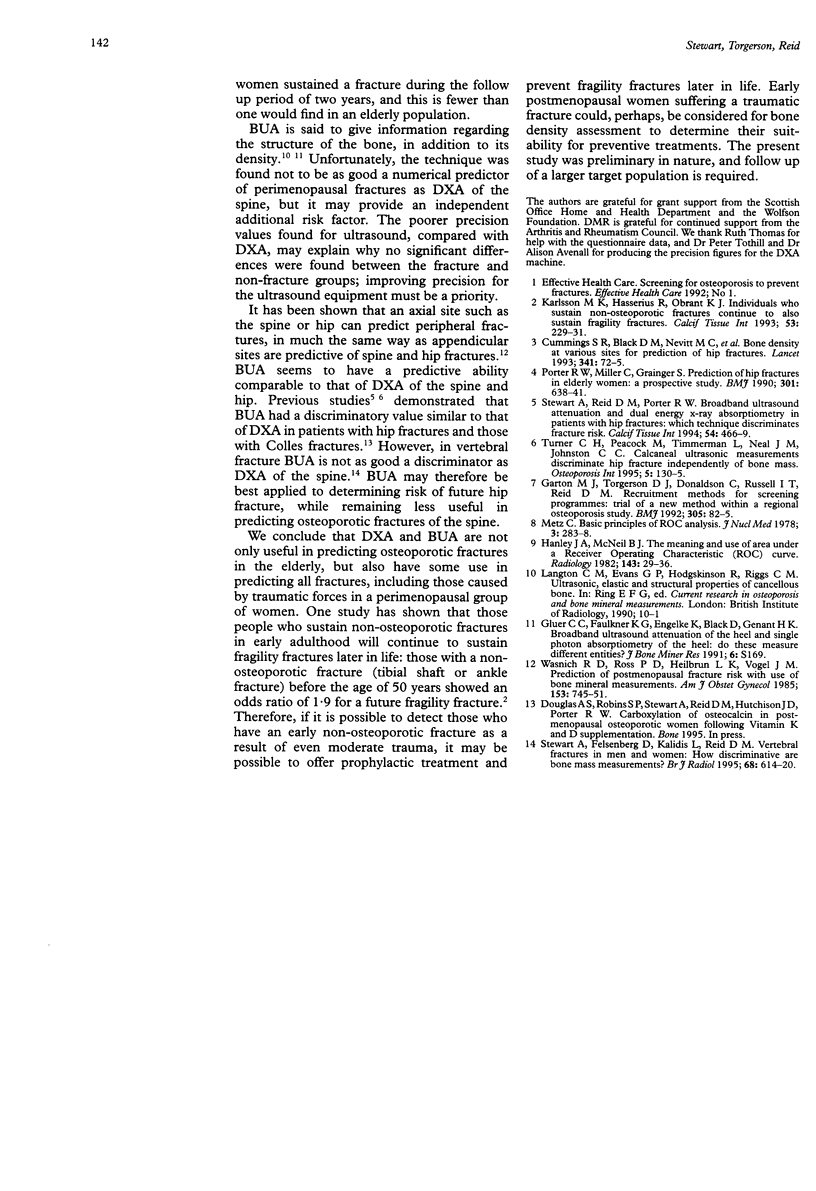Abstract
OBJECTIVE: To consider whether bone mineral density (BMD) measurements can predict traumatic fractures occurring in perimenopausal women. METHODS: One thousand perimenopausal women called up for screening underwent both dual energy x ray absorptiometry (DXA) of the spine and hip, and broadband ultrasound attenuation (BUA) of the heel. Two years later, they were sent a questionnaire to discover those who had since had a fracture, and compare them with those who had not. RESULTS: About 2% of the women had sustained a fracture in the two years since attendance for screening. Fractures in this age group can be predicted weakly, but significantly, by bone mass measurements using DXA and BUA (odds ratios from 1.4 to 2.1). The lumbar spine appeared to be one of the best predictive sites (odds ratio for 1 SD reduction in BMD 2.1 (95% confidence interval 1.2 to 3.8)), but no significant differences were found between the areas under the curve in receiver operator characteristic (ROC) analysis. CONCLUSION: In this preliminary study it appeared that bone mass measurements are predictive of perimenopausal traumatic fractures in addition to postmenopausal fractures related to osteoporosis. DXA of the lumbar spine did not perform significantly better than BUA. The number of fractures occurring was low, however, and further long term follow up is required to confirm the finding.
Full text
PDF


Selected References
These references are in PubMed. This may not be the complete list of references from this article.
- Cummings S. R., Black D. M., Nevitt M. C., Browner W., Cauley J., Ensrud K., Genant H. K., Palermo L., Scott J., Vogt T. M. Bone density at various sites for prediction of hip fractures. The Study of Osteoporotic Fractures Research Group. Lancet. 1993 Jan 9;341(8837):72–75. doi: 10.1016/0140-6736(93)92555-8. [DOI] [PubMed] [Google Scholar]
- Garton M. J., Torgerson D. J., Donaldson C., Russell I. T., Reid D. M. Recruitment methods for screening programmes: trial of a new method within a regional osteoporosis study. BMJ. 1992 Jul 11;305(6845):82–84. doi: 10.1136/bmj.305.6845.82. [DOI] [PMC free article] [PubMed] [Google Scholar]
- Hanley J. A., McNeil B. J. The meaning and use of the area under a receiver operating characteristic (ROC) curve. Radiology. 1982 Apr;143(1):29–36. doi: 10.1148/radiology.143.1.7063747. [DOI] [PubMed] [Google Scholar]
- Karlsson M. K., Hasserius R., Obrant K. J. Individuals who sustain nonosteoporotic fractures continue to also sustain fragility fractures. Calcif Tissue Int. 1993 Oct;53(4):229–231. doi: 10.1007/BF01320906. [DOI] [PubMed] [Google Scholar]
- Porter R. W., Miller C. G., Grainger D., Palmer S. B. Prediction of hip fracture in elderly women: a prospective study. BMJ. 1990 Sep 29;301(6753):638–641. doi: 10.1136/bmj.301.6753.638. [DOI] [PMC free article] [PubMed] [Google Scholar]
- Stewart A., Felsenberg D., Kalidis L., Reid D. M. Vertebral fractures in men and women: how discriminative are bone mass measurements? Br J Radiol. 1995 Jun;68(810):614–620. doi: 10.1259/0007-1285-68-810-614. [DOI] [PubMed] [Google Scholar]
- Stewart A., Reid D. M., Porter R. W. Broadband ultrasound attenuation and dual energy X-ray absorptiometry in patients with hip fractures: which technique discriminates fracture risk. Calcif Tissue Int. 1994 Jun;54(6):466–469. doi: 10.1007/BF00334324. [DOI] [PubMed] [Google Scholar]
- Wasnich R. D., Ross P. D., Heilbrun L. K., Vogel J. M. Prediction of postmenopausal fracture risk with use of bone mineral measurements. Am J Obstet Gynecol. 1985 Dec 1;153(7):745–751. doi: 10.1016/0002-9378(85)90338-2. [DOI] [PubMed] [Google Scholar]


